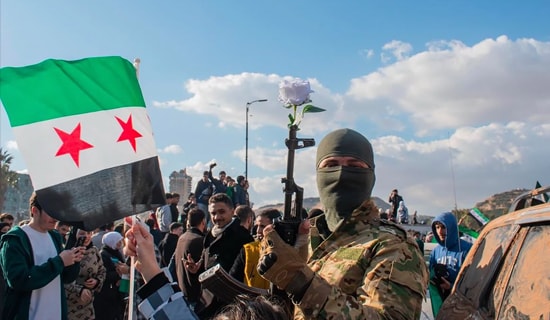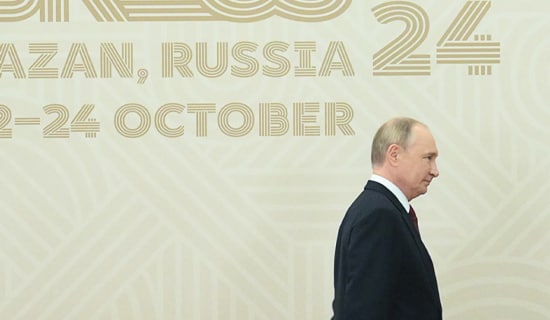The terrorist attacks of recent years in both Western and Arab countries, such as the U.S., the U.K., Spain, Iraq, Saudi Arabia, Kuwait, Morocco, and Egypt, have brought the problem of Islamist terrorism to the forefront of public debate in Arab countries. The debate has been raging since 9/11, and is now reflected even in cartoons in the major Arab media.
The attacks of 9/11 heralded a new era of terrorism by Muslim suicide bombers, who are striking at citizens around the world, not just at military targets or against Israel. Suicide attacks against Israel have had the support of the Arab public and of most Arab elites and religious clerics, who have justified this type of operation on the grounds that it has been directed at Israel's "state terrorism" against the Palestinians. The Palestinian suicide bombers have been portrayed as sacrificing themselves for the sake of a higher cause – Jihad for the sake of Allah – and as having secured their future in Paradise. There has also been support in the Arab world for the 9/11 attacks; they were deemed a reaction to "America's hegemony" over the world and a response to the "U.S.'s pro-Israel foreign policy."
Only when Islamists began to perpetrate acts of terror against Muslims in Arab countries did a debate arise over the issue of suicide attackers in the name of Islam. The hesitant, apologetic condemnations issued when the terrorism was directed against Israel and the U.S. were replaced by firm condemnation and denunciation of the attackers.
In Saudi Arabia, where various attacks have been carried out against the security forces, terrorists began to be considered "a group that has gone astray" ( al-fiaa al-dhalla ) and as "extremists" ( ghulah – a derogatory term from the religious perspective), who are interpreting the religious teachings in an intolerant manner. In addition, the frequent terrorist attacks in Iraq against the security forces and the civilian population, which have exacted a toll of hundreds of Arab casualties, have had a major impact on this debate.
Recently, against the backdrop of the Sharm Al-Sheikh bombings, the Sheikh of Al-Azhar, Dr. Muhammad Sayyed Tantawi, issued a fatwa stating that "whoever blows himself up is considered to be committing suicide, except for the resistance operations in Palestine, whose perpetrators are Shahids..." According to Tantawi, those who carry out terrorist attacks in the Arab world are not waging Jihad "because Jihad means fighting the enemy, not [Muslim] believers..." Sheikh Tantawi added: "The Islamic Shari'a forbids the killing of innocent civilians, women and children, whether Muslim or not. As long as they live among us in harmony and peace, Allah forbids us to forfeit their blood." [1]
The development of the public debate on terrorism is reflected in the cartoons published in the printed Arab media. With the rise in terror attacks, there has been a belated rise in the number of cartoons denouncing terrorism. In the cartoons now appearing in the Arab world, terrorism is depicted as an octopus taking over the world; as a snake; as an armed masked man with bloodstained hands; as the Grim Reaper; as a knife stabbing the Arabs in the back; as an armed hooligan who wants to tyrannize the world; and as a satanic or bestial figure setting the world on fire.
Alongside the cartoons that mitigate their condemnation of terrorism with justifications, such as Israeli and U.S. policies, some cartoons in the Arab media denounce terrorism unequivocally. For example, the Saudi daily Al-Madina featured a cartoon in which knife-wielding hands encompass the world, forming a swastika. The cartoon is titled "The Murder of Innocent People is a New Nazism." [2]
A smaller number of cartoons deal with the extremism motivating terrorism and with the Arab response to terrorism. For example, the London-based Arabic daily Al-Sharq Al-Awsat featured a cartoon in which an Arab denounces terrorism through a small megaphone, while "humanity" demands that he denounce it more loudly, through a much larger megaphone. [3] The Bahraini daily Al-Ayyam portrays extremism as the Grim Reaper patting the head of a young boy who is making his way to school. [4] Extremist thinking is depicted as Osama bin Laden who has closed himself off in a narrow, restricted circle, in a cartoon in the Saudi daily Al-Watan . [5]
It should be noted that Arab cartoons do not often feature bin Laden and Al-Qaeda. Thus, particularly notable is a cartoon in the Saudi daily Al-Watan , of bin Laden and his deputy Ayman Al-Zawahiri tied together by their legs, fleeing rockets fired at them. In this cartoon, which mocks Al-Qaeda's leaders, Al-Zawahiri says to bin Laden: "I think it's time you fled on your own!" [6]
The treatment in cartoons of the phenomenon of beheadings demonstrates the delay in dealing with it. Only after the intensification of the debate following the targeting of Arabs (such as the execution of Egyptian Ambassador to Iraq Ihab Al-Sharif) did the cartoons begin to tackle the subject. Thus, for example, the Saudi daily Al-Yawmfeatured a cartoon portraying a man clad in black, with a black balloon head, holding the head of another man whose tied-up corpse lies nearby, and brandishing a bloodstained knife with his other hand. [7]
The following are examples of anti-terrorism cartoons that appeared recently in the Arabic press:
Terrorism as Nazism
Cartoon No. 1: "The murder of innocent people is a new Nazism."  From Al-Madina (Saudi Arabia), July 12, 2005. [8]
From Al-Madina (Saudi Arabia), July 12, 2005. [8]
Terrorism as an Octopus Taking Over the World
Cartoon No. 2 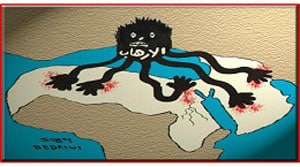 From the reform website www.elaph.com , May 2, 2005. [9] The cartoon reappeared in the Egyptian weekly October , on July 30, 2005. Cartoon No. 3
From the reform website www.elaph.com , May 2, 2005. [9] The cartoon reappeared in the Egyptian weekly October , on July 30, 2005. Cartoon No. 3 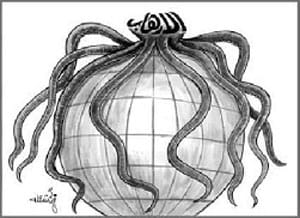 From Al-Rai (Jordan), July 25, 2005. [10]
From Al-Rai (Jordan), July 25, 2005. [10]
Cartoon No. 4: "Terrorism" depicted as an octopus whose explosives-clad tentacles encompass the world and are fed by a missile termed "Bush's Wars."
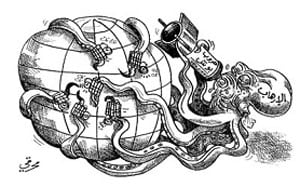
From Akhbar Al-Khaleej (Bahrain), July 25, 2005. [11]
Terrorism as a Snake
Cartoon No. 5  From Al-Rai (Jordan), August 22, 2005. [12]
From Al-Rai (Jordan), August 22, 2005. [12]
Terrorism Tyrannizing the World
Cartoon No. 6  From Al-Itihad (UAE), July 25, 2005. [13]
From Al-Itihad (UAE), July 25, 2005. [13]
Terrorism as the Grim Reaper
Cartoon No. 7  From Al-Watan (Qatar), July 11, 2005. [14] Cartoon No. 8: Terrorism as the Grim Reaper in an explosives-laden car en route to Doha, Qatar.
From Al-Watan (Qatar), July 11, 2005. [14] Cartoon No. 8: Terrorism as the Grim Reaper in an explosives-laden car en route to Doha, Qatar.  From Al-Watan (Qatar), March 21, 2005. [15]
From Al-Watan (Qatar), March 21, 2005. [15]
The Terrorists Portrayed as Beasts
Cartoon No. 9: Bestial hands push the world towards the flames of "terrorism."  From Al-Rai (Jordan), July 10, 2005. [16] Cartoon No. 10: Bestial hands light a bomb in London's Tube.
From Al-Rai (Jordan), July 10, 2005. [16] Cartoon No. 10: Bestial hands light a bomb in London's Tube.  From Akhbar Al-Khaleej (Bahrain), July 22, 2005. [17]
From Akhbar Al-Khaleej (Bahrain), July 22, 2005. [17]
Terrorism with a Masked Face
Cartoon No. 11  From Al-Watan (Qatar), July 25, 2005. [18] Cartoon No. 12
From Al-Watan (Qatar), July 25, 2005. [18] Cartoon No. 12 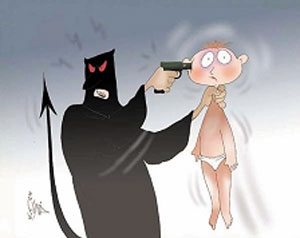 From Al-Ayyam (Bahrain), July 25, 2005. [19]
From Al-Ayyam (Bahrain), July 25, 2005. [19]
"No" to Terrorism
Cartoon No. 13  From Al-Madina (Saudi Arabia), July 21, 2005. [20] Cartoon No. 14
From Al-Madina (Saudi Arabia), July 21, 2005. [20] Cartoon No. 14  From Al-Itihad (UAE), July 24, 2005. [21]
From Al-Itihad (UAE), July 24, 2005. [21]
"Terrorism" as a Knife in Egypt's Back
Cartoon No. 15 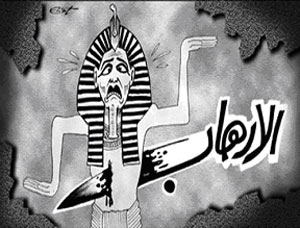 From Al-Watan (Qatar), May 2, 2005. [22]
From Al-Watan (Qatar), May 2, 2005. [22]
Satanic Figures Talk after the Sharm Al-Sheikh Bombings
Cartoon No. 16: "What did those animals [i.e. the terrorists] say, what faction are they from?" "Those who committed this act are most despicable, they stooped lower than us." 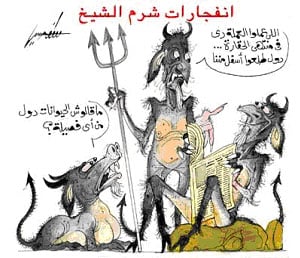 From Al-Akhbar (Egypt), July 25, 2005. [23]
From Al-Akhbar (Egypt), July 25, 2005. [23]
Beheadings
Cartoon No. 17 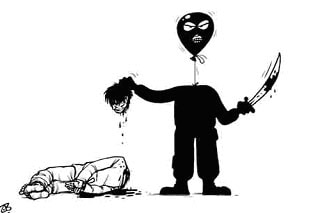 From Al-Yawm (Saudi Arabia), July 31, 2005. [24]
From Al-Yawm (Saudi Arabia), July 31, 2005. [24]
Condemnation of Terrorism
Cartoon No. 18: The weak Arab voice condemns terrorism, while "humanity" demands a stronger condemnation. 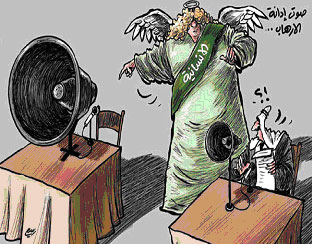 From Al-Sharq Al-Awsat (London), July 31, 2005. [25]
From Al-Sharq Al-Awsat (London), July 31, 2005. [25]
The Causes of Terrorism
Cartoon No. 19: "Extremism"  From Al-Ayyam (Bahrain), July 27, 2005. [26]
From Al-Ayyam (Bahrain), July 27, 2005. [26]
Mocking Al-Qaeda
Cartoon No. 20: Ayman Al-Zawahiri to Bin Laden: "I think it's time you fled on your own!" 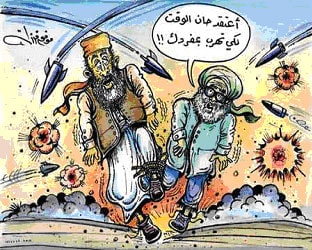 From Al-Watan (Saudi Arabia), July 6, 2005. [27] Cartoon No. 21: "Extremist Thinking"
From Al-Watan (Saudi Arabia), July 6, 2005. [27] Cartoon No. 21: "Extremist Thinking" 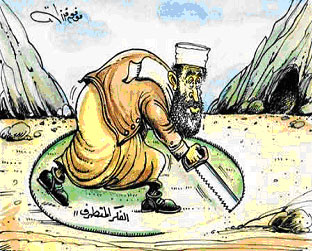 From Al-Watan (Saudi Arabia), July 11, 2005. [28]
From Al-Watan (Saudi Arabia), July 11, 2005. [28]
*A. Dankowitz is Director of MEMRI's Reform Project
Endnotes:
[1] Sada Al-Balad (Lebanon), July 31, 2005.
[2] Al-Madina (Saudi Arabia), July 12, 2005.
[3] Al-Sharq Al-Awsat (London), July 31, 2005.
[4] Al-Ayyam (Bahrain), July 27, 2005.
[5] Al-Watan (Saudi Arabia), July 11, 2005.
[6] Al-Watan (Saudi Arabia), July 6, 2005.
[7] Al-Yawm (Saudi Arabia), July 31, 2005.
[8] http://www.almadinapress.com/index.aspx?Issueid=1026&pubid=1&catid=256.
[9] http://www.elaph.com/ElaphCartoons/CartoonDetails?imageid=59289
[10] http://www.alrai.com/pages.php?caricature=1
[11] http://www.akhbar-alkhaleej.com/cartoons.asp?Sn=CART
[12] http://www.alrai.com/pages.php?caricature=1#
[13] http://www.alittihad.co.ae/caricatures.asp?a=1&channel=11&journal=7/25/2005
[14] http://www.al-watan.com/data/20050711/index.asp?page=cartoon.htm
[15] http://www.al-watan.com/data/20050321/index.asp?page=cartoon.htm
[16] http://www.alrai.com/pages.php?caricature=1
[17] http://www.akhbar-alkhaleej.com/cartoons.asp?Sn=CART
[18] http://www.al-watan.com/data/20050725/index.asp?page=cartoon.htm
[19] http://www.alayam.com/ArticleDetail.asp
[20] http://www.almadinapress.com/index.aspx?Issueid=1039&pubid=1&catid=256
[21] http://www.alittihad.co.ae/caricatures.asp?a=1&channel=11&journal=7/24/2005
[22] http://www.al-watan.com/data/20050502/index.asp?page=cartoon.htm
[23] http://www.elakhbar.org.eg/issues/16616/1300.html
[24] http://www.alyaum.com/issue/page.php?IN=11734&P=13
[25] http://www.aawsat.com/sections.asp?section=27&issue=9742
[26] http://www.alayam.com/ArticleDetail.asp
[27] http://www.alwatan.com.sa/daily/2005-07-06/caricature.htm
[28] http://www.alwatan.com.sa/daily/2005-07-11/caricature.htm



